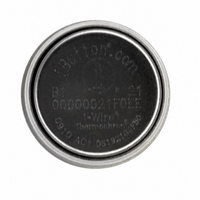DS1921G-F5# Maxim Integrated Products, DS1921G-F5# Datasheet - Page 18

DS1921G-F5#
Manufacturer Part Number
DS1921G-F5#
Description
IBUTTON THERMOCHRON F5
Manufacturer
Maxim Integrated Products
Series
iButton®r
Datasheet
1.DS1921G-F5.pdf
(42 pages)
Specifications of DS1921G-F5#
Rohs Information
IButton RoHS Compliance Plan
Memory Size
512B
Memory Type
NVSRAM (Non-Volatile SRAM)
Ic Output Type
Digital
Sensing Accuracy Range
± 1.3°C
Supply Current
10µA
Supply Voltage Range
2.8V To 5.25V
Termination Type
Quick Connect
Operating Temperature Range
-40°C To +85°C
Supply Voltage Min
2.8V
Rohs Compliant
Yes
Filter Terminals
Quick Connect
Accuracy %
1°C
Lead Free Status / RoHS Status
Lead free / RoHS Compliant
Available stocks
Company
Part Number
Manufacturer
Quantity
Price
Thermochron iButton
Figure 8. Alarm Timestamps and Durations Address Map
214h). This way, if the search conditions (address
20Eh) are set accordingly, the master can quickly iden-
tify devices with temperature alarms by means of the
conditional search function (see the ROM Function
Commands section). The device also generates a time-
stamp of when the alarm occurred and begins record-
ing the duration of the alarming temperature.
Timestamps and durations where the temperature
leaves the tolerance band are stored in the address
range 0220h to 027Fh, as shown in Figure 8. This allo-
cation allows recording 24 individual alarm events and
periods (12 periods for too hot and 12 for too cold). The
date and time of each of these periods can be deter-
mined from the Mission Timestamp register and the
time distance between each temperature reading.
The alarm timestamp is a copy of the Mission Samples
Counter register when the alarm first occurred. The
least significant byte is stored at the lower address.
One address higher than the timestamp, the DS1921G
maintains a 1-byte duration counter that stores the
number of samples the temperature was found to be
beyond the threshold. If this counter has reached its
limit after 255 consecutive temperature readings and
the temperature has not yet returned to within the toler-
ance band, the device issues another timestamp at the
next higher alarm location and opens another counter
to record the duration. If the temperature returns to nor-
mal before the counter has reached its limit, the dura-
18
______________________________________________________________________________________
0224h to 0227h
0228h to 024Fh
0254h to 0257h
0258h to 027Fh
ADDRESS
0220h
0221h
0222h
0223h
0250h
0251h
0252h
0253h
Mission Samples Counter, Center Byte
Mission Samples Counter, Center Byte
Mission Samples Counter, High Byte
Mission Samples Counter, High Byte
Mission Samples Counter, Low Byte
Mission Samples Counter, Low Byte
Alarm Timestamp and Durations
Alarm Timestamp and Durations
Alarm Timestamp and Duration
Alarm Timestamp and Duration
Alarm Duration Counter
Alarm Duration Counter
DESCRIPTION
tion counter of the particular timestamp does not incre-
ment any further. Should the temperature again cross
this threshold, it is recorded at the next available alarm
location. This algorithm is implemented for the low tem-
perature thresholds as well as for the high temperature
threshold.
The typical task of the DS1921G iButton is recording
the temperature of a temperature-sensitive object.
Before the device can perform this function, it needs to
be configured. This procedure is called missioning.
First, the DS1921G must have its RTC set to a valid time
and date. This reference time can be UTC (also called
GMT, Greenwich Mean Time) or any other time stan-
dard that was chosen for the application. The clock
must be running (EOSC = 0) for at least one second.
Setting an RTC alarm is optional. The memory assigned
to store the alarm timestamps and durations, tempera-
ture histogram, Mission Timestamp, Mission Samples
Counter, Mission Start Delay, and Sample Rate must be
cleared using the Clear Memory command. In case
there were temperature alarms in the previous mission,
the TLF and THF flags need to be cleared manually. To
enable the device for a mission, the EM flag must be
set to 0. These are general settings that have to be
made regardless of the type of object to be monitored
and the duration of the mission.
High Alarms 3 to 12
Low Alarms 3 to 12
ALARM EVENT
High Alarm 1
High Alarm 2
Low Alarm 1
Low Alarm 2
Missioning













